Sebastian Semper
Measurement-based Evaluation of CNN-based Detection and Estimation for ISAC Systems
Jul 02, 2025Abstract:In wireless sensing applications, such as ISAC, one of the first crucial signal processing steps is the detection and estimation targets from a channel estimate. Effective algorithms in this context must be robust across a broad SNR range, capable of handling an unknown number of targets, and computationally efficient for real-time implementation. During the last decade, different Machine Learning methods have emerged as promising solutions, either as standalone models or as complementing existing techniques. However, since models are often trained and evaluated on synthetic data from existing models, applying them to measurement is challenging. All the while, training directly on measurement data is prohibitive in complex propagation scenarios as a groundtruth is not available. Therefore, in this paper, we train a CNN approach for target detection and estimation on synthetic data and evaluate it on measurement data from a suburban outdoor measurement. Using knowledge of the environment as well as available groundtruth positions, we study the detection probability and accuracy of our approach. The results demonstrate that our approach works on measurement data and is suitable for joint detection and estimation of sensing targets in ISAC systems.
Benchmarking CFAR and CNN-based Peak Detection Algorithms in ISAC under Hardware Impairments
May 16, 2025



Abstract:Peak detection is a fundamental task in radar and has therefore been studied extensively in radar literature. However, Integrated Sensing and Communication (ISAC) systems for sixth generation (6G) cellular networks need to perform peak detection under hardware impairments and constraints imposed by the underlying system designed for communications. This paper presents a comparative study of classical Constant False Alarm Rate (CFAR)-based algorithms and a recently proposed Convolutional Neural Network (CNN)-based method for peak detection in ISAC radar images. To impose practical constraints of ISAC systems, we model the impact of hardware impairments, such as power amplifier nonlinearities and quantization noise. We perform extensive simulation campaigns focusing on multi-target detection under varying noise as well as on target separation in resolution-limited scenarios. The results show that CFAR detectors require approximate knowledge of the operating scenario and the use of window functions for reliable performance. The CNN, on the other hand, achieves high performance in all scenarios, but requires a preprocessing step for the input data.
Joint Delay-Doppler Estimation using OFDMA Payloads for Integrated Sensing and Communications
Mar 06, 2025

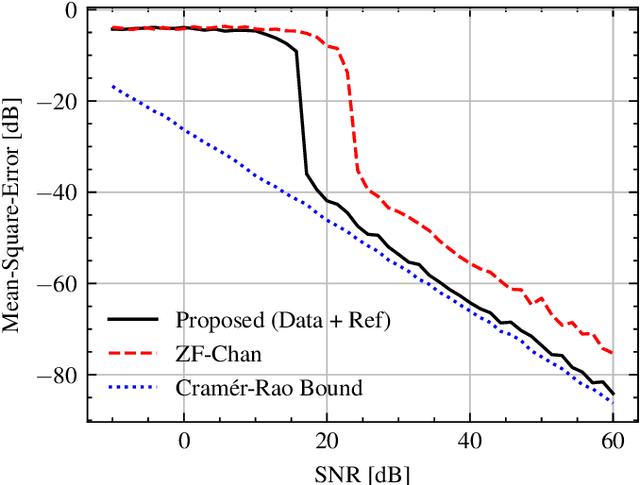

Abstract:The use of future communication systems for sensing offers the potential for a number of new applications. In this paper, we show that leveraging user data payloads in multi-node Orthogonal Frequency Division Multiple Access (OFDMA) networks for estimating target delay and Doppler-shift parameters can yield a significant advantage in SNR and addressable bandwidth. However, gaps in the frequency-time resources, reference signal boosting and amplitude modulation schemes introduce challenges for estimation at the sensing receiver. In this work, we propose a joint delay and Doppler-shift model-based estimator designed to address these challenges. Furthermore, we demonstrate that incorporating knowledge of the device model into the estimation procedure helps mitigate the effects of the non-ideal radar ambiguity function caused by amplitude-modulated user payloads and sparse reference signals. Simulation results demonstrate that the estimator achieves the theoretical lower bound on estimation variance.
Newtonized Orthogonal Matching Pursuit for High-Resolution Target Detection in Sparse OFDM ISAC Systems
Nov 05, 2024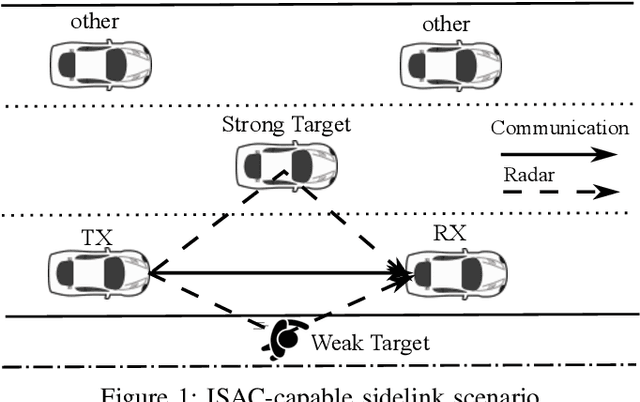
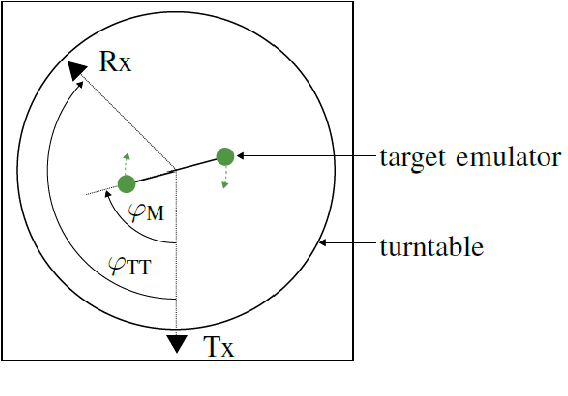
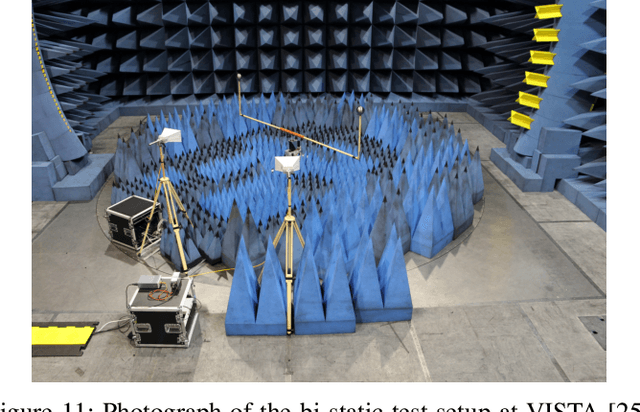
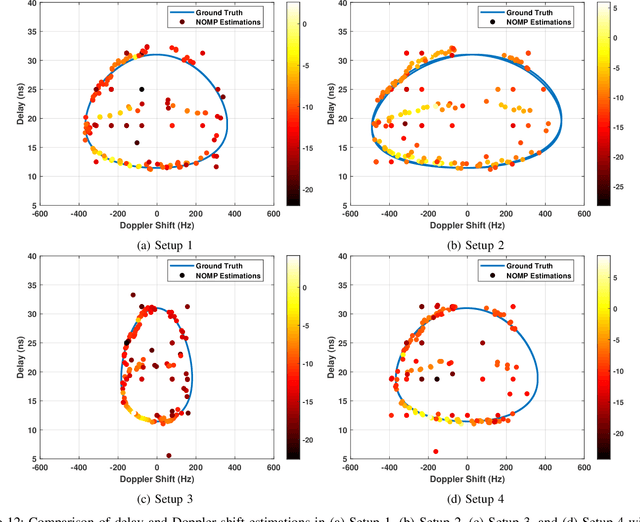
Abstract:Integrated Sensing and Communication (ISAC) is a technology paradigm that combines sensing capabilities with communication functionalities in a single device or system. In vehicle-to-everything (V2X) sidelink, ISAC can provide enhanced safety by allowing vehicles to not only communicate with one another but also sense the surrounding environment by using sidelink signals. In ISAC-capable V2X sidelink, the random resource allocation results in an unstructured and sparse distribution of time and frequency resources in the received orthogonal frequency division multiplexing (OFDM) grid, leading to degraded radar detection performance when processed using the conventional 2D-FFT method. To address this challenge, this paper proposes a high-resolution off-grid radar target detection algorithm irrespective of the OFDM grid structure. The proposed method utilizes the Newtonized orthogonal matching pursuit (NOMP) algorithm to effectively detect weak targets masked by the sidelobes of stronger ones and accurately estimates off-grid range and velocity parameters with minimal resources through Newton refinements. Simulation results demonstrate the superior performance of the proposed NOMP-based target detection algorithm compared to existing compressed sensing (CS) methods in terms of detection probability, resolution, and accuracy. Additionally, experimental validation is performed using a bi-static radar setup in a semi-anechoic chamber. The measurement results validate the simulation findings, showing that the proposed algorithm significantly enhances target detection and parameter estimation accuracy in realistic scenarios.
Misspecification of Multiple Scattering in Scalar Wave Fields and its Impact in Ultrasound Tomography
May 02, 2024



Abstract:In this work, we investigate the localization of targets in the presence of multiple scattering. We focus on the often omitted scenario in which measurement data is affected by multiple scattering, and a simpler model is employed in the estimation. We study the impact of such model mismatch by means of the Misspecified Cram\'er-Rao Bound (MCRB). In numerical simulations inspired by tomographic inspection in ultrasound nondestructive testing, the MCRB is shown to correctly describe the estimation variance of localization parameters under misspecification of the wave propagation model. We provide extensive discussion on the utility of the MCRB in the practical task of verifying whether a chosen misspecified model is suitable for localization based on the properties of the maximum likelihood estimator and the nuanced distinction between bias and parameter space differences. Finally, we highlight that careful interpretation is needed whenever employing the classical CRB in the presence of mismatch through numerical examples based on the Born approximation and other simplified propagation models stemming from it.
Improving the Spatial Correlation Characteristics of Antenna Arrays using Linear Operators and Wide-band Modelling
Mar 26, 2024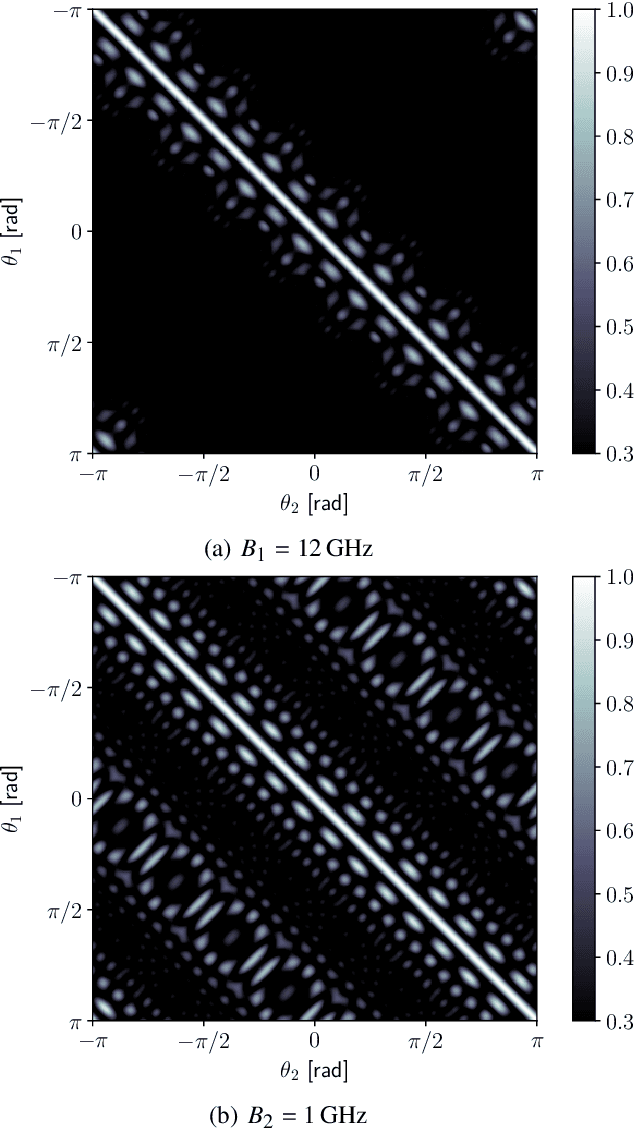

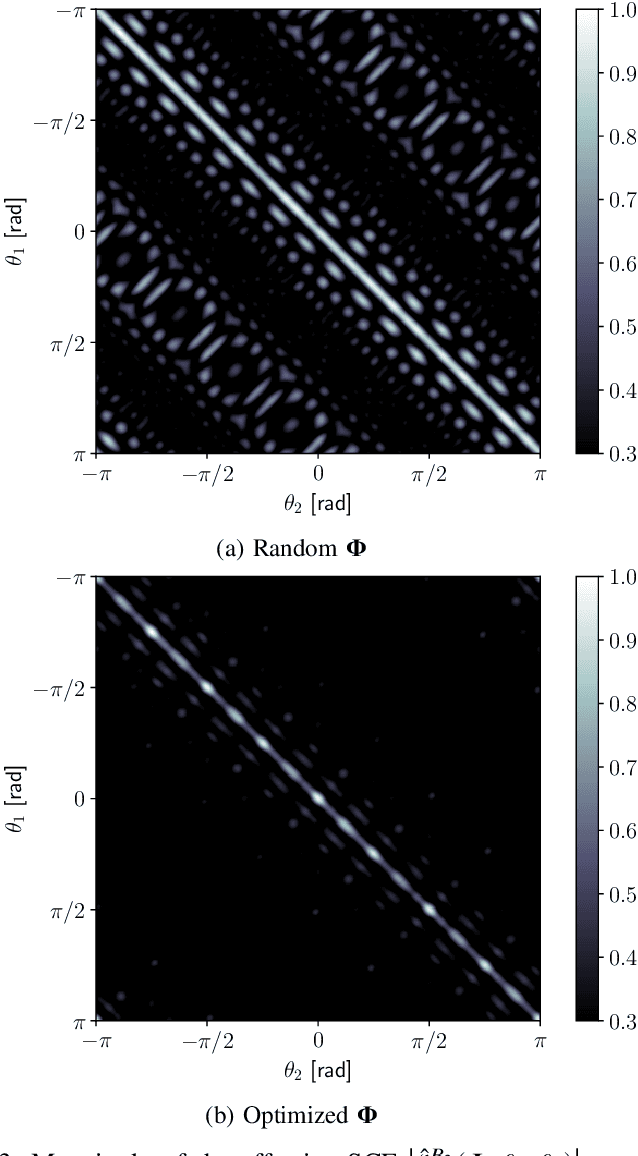
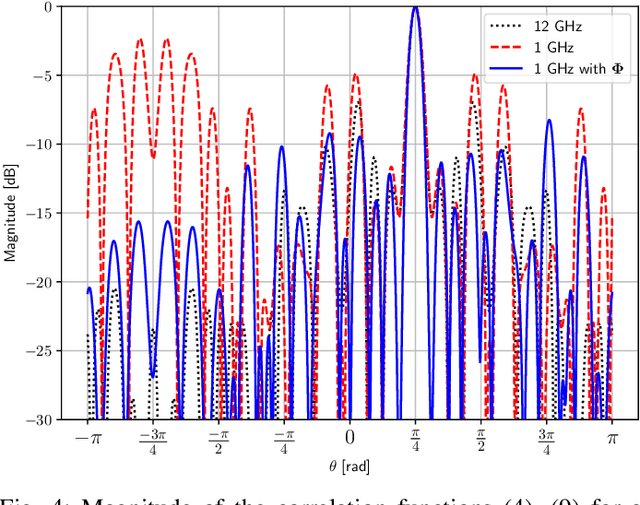
Abstract:The analysis of wireless communication channels at the mmWave, sub-THz and THz bands gives rise to difficulties in the construction of antenna arrays due to the small maximum inter-element spacing constraints at these frequencies. Arrays with uniform spacing greater than half the wavelength for a certain carrier frequency exhibit aliasing side-lobes in the angular domain, prohibiting non-ambiguous estimates of a propagating wave-front's angle of arrival. In this paper, we present how wide-band modelling of the array response is useful in mitigating this spatial aliasing effect. This approach aims to reduce the grating lobes by exploiting the angle- and frequency-dependent phase-shifts observed in the response of the array to a planar wave-front travelling across it. Furthermore, we propose a method by which the spatial correlation characteristics of an array operating at 33 GHz carrier frequency with an instantaneous bandwidth of 1 GHz can be improved such that the angular-domain side-lobes are reduced by 5-10 dB. This method, applicable to arbitrary antenna array manifolds, makes use of a linear operator that is applied to the base-band samples of the channel transfer function measured in space and frequency domains. By means of synthetically simulated arrays, we show that when operating with a bandwidth of 1 GHz, the use of a derived linear operator applied to the array output results in the spatial correlation characteristics approaching those of the array operating at a bandwidth of 12 GHz. Hence, non-ambiguous angle estimates can be obtained in the field without the use of expensive high-bandwidth RF front-end components.
A Framework for Developing and Evaluating Algorithms for Estimating Multipath Propagation Parameters from Channel Sounder Measurements
Oct 12, 2023
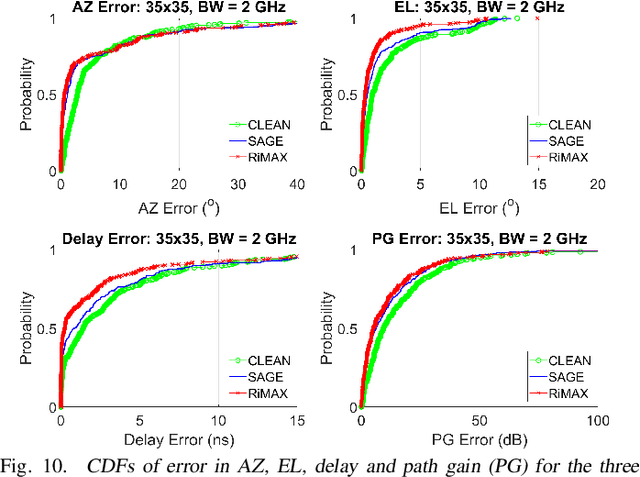
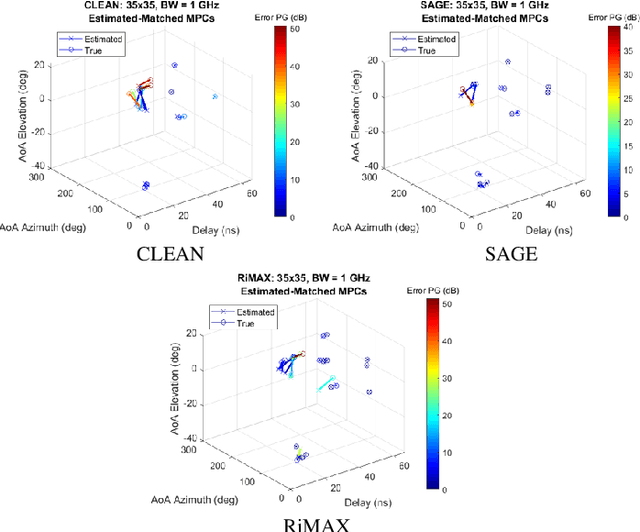
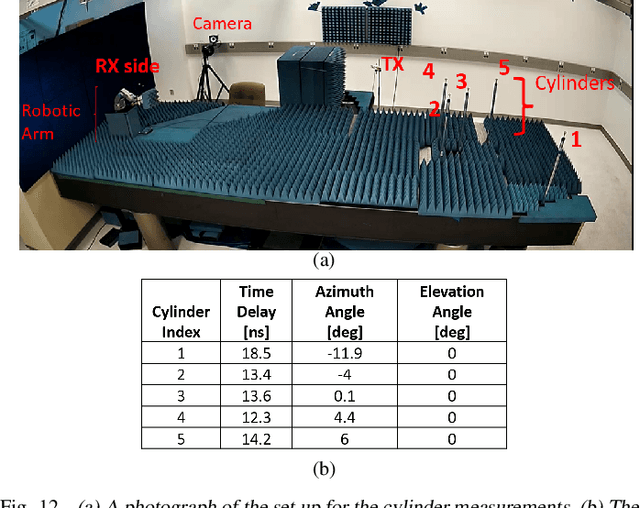
Abstract:A framework is proposed for developing and evaluating algorithms for extracting multipath propagation components (MPCs) from measurements collected by channel sounders at millimeter-wave frequencies. Sounders equipped with an omnidirectional transmitter and a receiver with a uniform planar array (UPA) are considered. An accurate mathematical model is developed for the spatial frequency response of the sounder that incorporates the non-ideal cross-polar beampatterns for the UPA elements. Due to the limited Field-of-View (FoV) of each element, the model is extended to accommodate multi-FoV measurements in distinct azimuth directions. A beamspace representation of the spatial frequency response is leveraged to develop three progressively complex algorithms aimed at solving the singlesnapshot maximum likelihood estimation problem: greedy matching pursuit (CLEAN), space-alternative generalized expectationmaximization (SAGE), and RiMAX. The first two are based on purely specular MPCs whereas RiMAX also accommodates diffuse MPCs. Two approaches for performance evaluation are proposed, one with knowledge of ground truth parameters, and one based on reconstruction mean-squared error. The three algorithms are compared through a demanding channel model with hundreds of MPCs and through real measurements. The results demonstrate that CLEAN gives quite reasonable estimates which are improved by SAGE and RiMAX. Lessons learned and directions for future research are discussed.
Estimating Multi-Modal Dense Multipath Components using Auto-Encoders
Dec 05, 2022Abstract:We present a maximum-likelihood estimation algorithm for radio channel measurements exhibiting a mixture of independent Dense Multipath Components. The novelty of our approach is in the algorithms initialization using a deep learning architecture. Currently, available approaches can only deal with scenarios where a single mode is present. However, in measurements, two or more modes are often observed. This much more challenging multi-modal setting bears two important questions: How many modes are there, and how can we estimate those? To this end, we propose a Neural Net-architecture that can reliably estimate the number of modes present in the data and also provide an initial assessment of their shape. These predictions are used to initialize for gradient- and model-based optimization algorithm to further refine the estimates. We demonstrate numerically how the presented architecture performs on measurement data and analytically study its influence on the estimation of specular paths in a setting where the single-modal approach fails.
* https://ieeexplore.ieee.org/document/9909796
Estimation of Signal Parameters using Deep Convolutional Neural Networks
Nov 09, 2022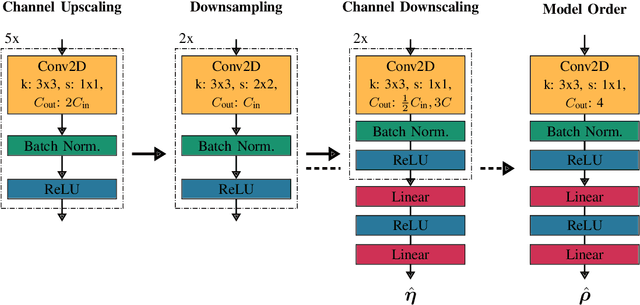
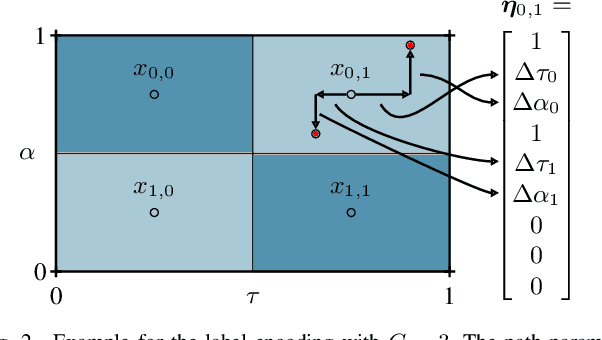

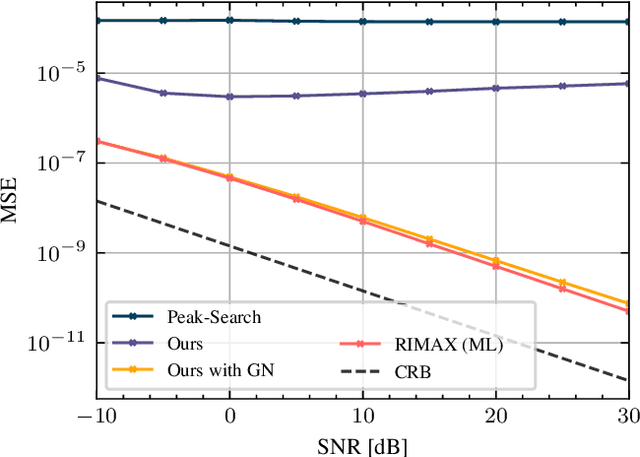
Abstract:This paper introduces a Deep Learning approach for signal parameter estimation in the context of wireless channel modeling. Our work is capable of multidimensional parameter estimation from a signal containing an unknown number of paths. The signal parameters are estimated relative to a predefined grid, providing quasi grid-free, hence, more accurate estimates than previous grid-limited approaches. It requires no prior knowledge of the number of paths, giving it an advantage in terms of complexity compared to existing solutions. Along with the description, we provide an initial performance analysis and a comparison with State-of-the-Art techniques and discuss future research directions.
 Add to Chrome
Add to Chrome Add to Firefox
Add to Firefox Add to Edge
Add to Edge